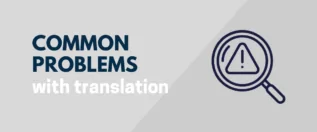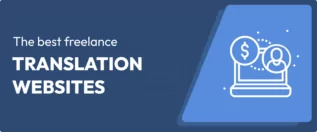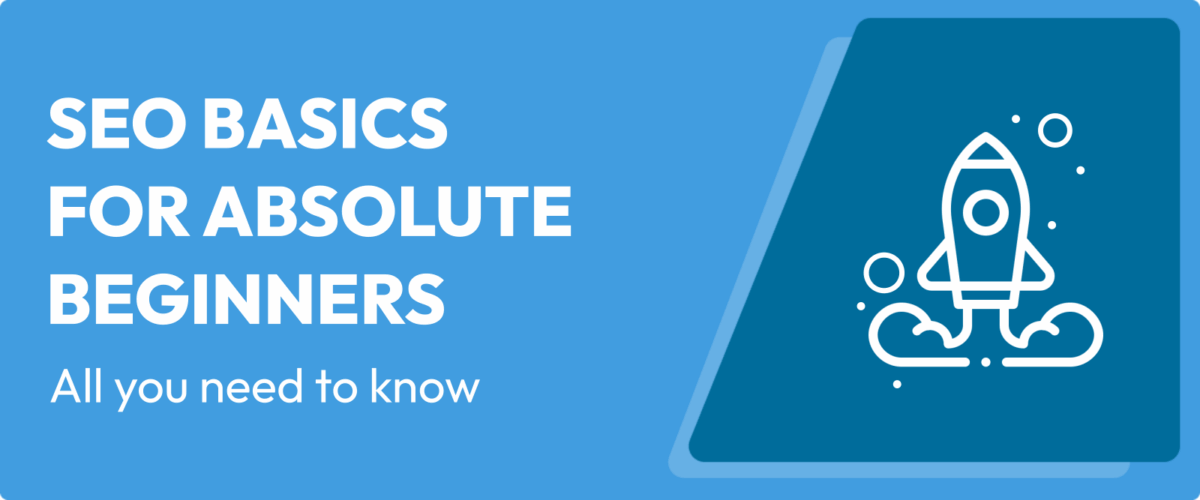
In this post
This will be a tutorial on SEO basics for absolute beginners. If you feel like you don’t really know what SEO is, why it matters, and how to use it to improve the visibility and traffic on your website, this is the place for you.
Below, we’ll cover exactly that. Follow along and you’ll walk away with a solid grasp of what to do to improve your website’s SEO and its performance in search engines.
What is SEO and Why Does It Matter?
SEO stands for “Search Engine Optimization.” In essence, it means configuring your site so that it appears prominently in services like Google, Bing, and Yahoo, and brings in relevant organic traffic.
Organic traffic refers to visitors who come from search results that appear naturally on a search page rather than through paid ads.

What’s important to note is that higher-ranked pages receive a disproportionate number of clicks.
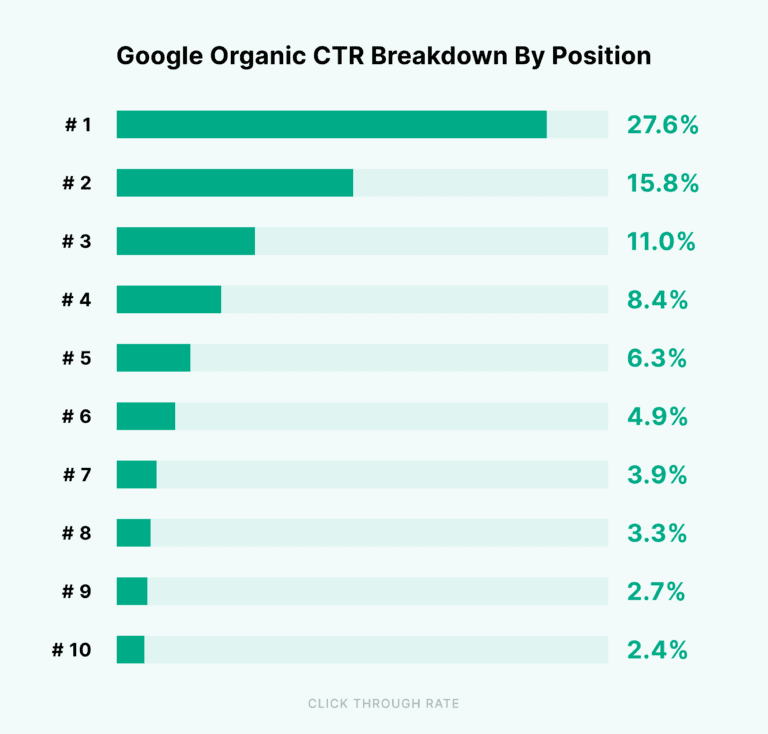
Thus, the higher you can place in search result pages, the more visitors you can expect to receive. And more visitors means more chances of turning them into customers, leads, or other valuable outcomes that drive revenue and profit.
Benefits of SEO
Search engines aren’t the only way to attract visitors to your website. You can also generate traffic through social media marketing, an email newsletter, or paid ads. However, SEO stands out because, unlike these other methods, it provides consistent and passive traffic.
Why?
Because the number of searches for a keyword generally stays roughly the same, so if you manage to rank highly for one, you can expect a regular flow of visitors without ongoing effort.
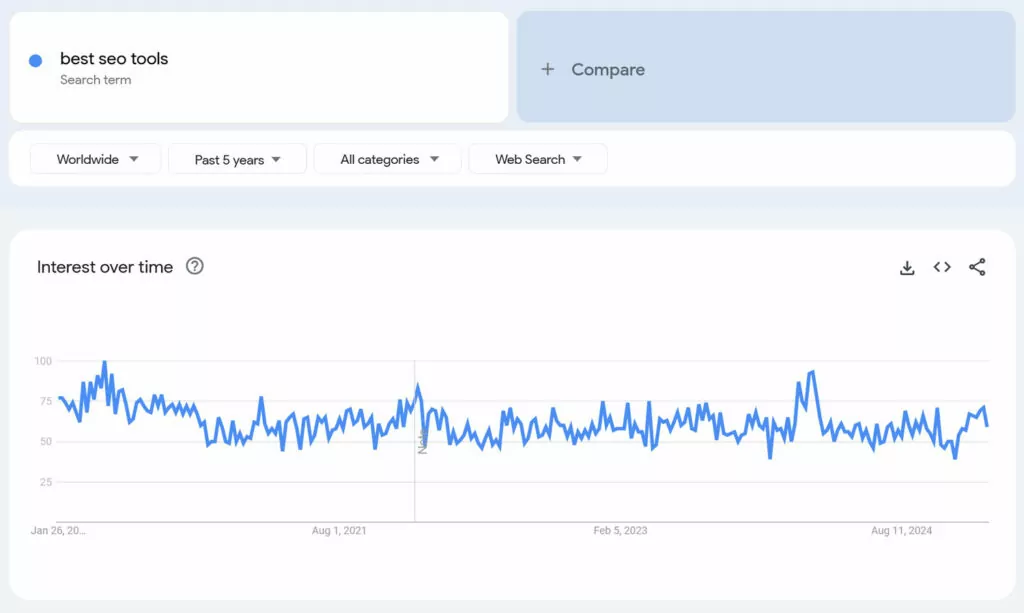
In contrast, social media traffic tends to spike briefly and then drop off, while paid ads stop driving traffic as soon as you stop funding them.
Another advantage of SEO is that it’s “free” in the sense that you don’t have to pay for clicks. It does require time and effort, but once established, it continues to deliver traffic long-term.
SEO is also beneficial beyond just traffic—it helps build your brand visibility and credibility. The more often your website appears in relevant searches, the more people become aware of your company’s existence. Over time, this builds trust and makes users more likely to choose you when they need your product or service.
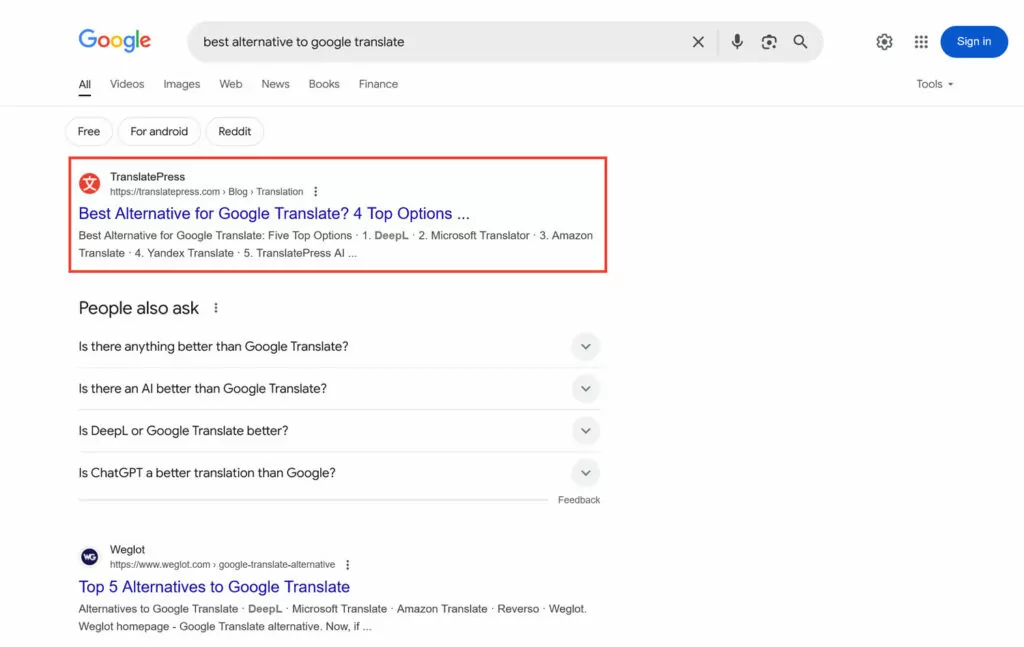
Additionally, SEO improves the overall quality of your website because, as you will see, user experience is one of its key factors. A well-optimized site not only ranks better but also provides a smoother, faster, and more accessible experience for visitors.
Be aware, however, that SEO is a long-term strategy and ongoing process. It doesn’t deliver instant results, but when done correctly, creates sustainable traffic in the long run. And, since SEO best practices evolve over time, it’s also important to stay up to date and adjust your strategy as needed.
SEO Basics: How Do You Do SEO?
Let’s now look at how to apply SEO to your website, even if you’re a complete beginner.
1. Make Sure Your Website Can Be Indexed
To understand what “indexing” means, you first need to know how search engines work.
Google and other search providers constantly scan the web using automated programs called “crawlers.” These crawlers search for new and updated web pages, typically by following links from other websites or when someone directly submits page URLs through webmaster tools.
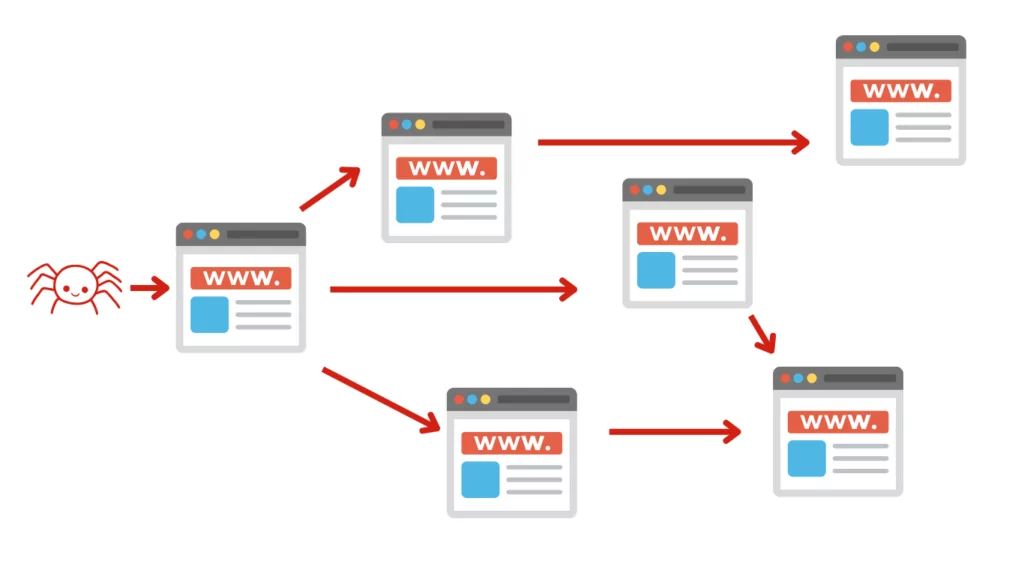
Once a crawler finds a page, it scans its content. If the content meets certain quality criteria, the page’s information is added to the search engine’s library of pages, the so-called “index.” Whenever a user enters a search query, the search engine goes through its index to find the most relevant results and presents them to the user.
Consequently, your site can only appear in search results if it can be indexed and making sure that that’s the case is one of the most fundamental SEO basics.
Use the Site: Operator
A quick way to check if your website is being indexed is to use the site: operator in Google. By typing site:yourwebsite.com into the search bar (replace yourwebsite.com with your actual domain), you’ll see all the pages Google has indexed from your website.
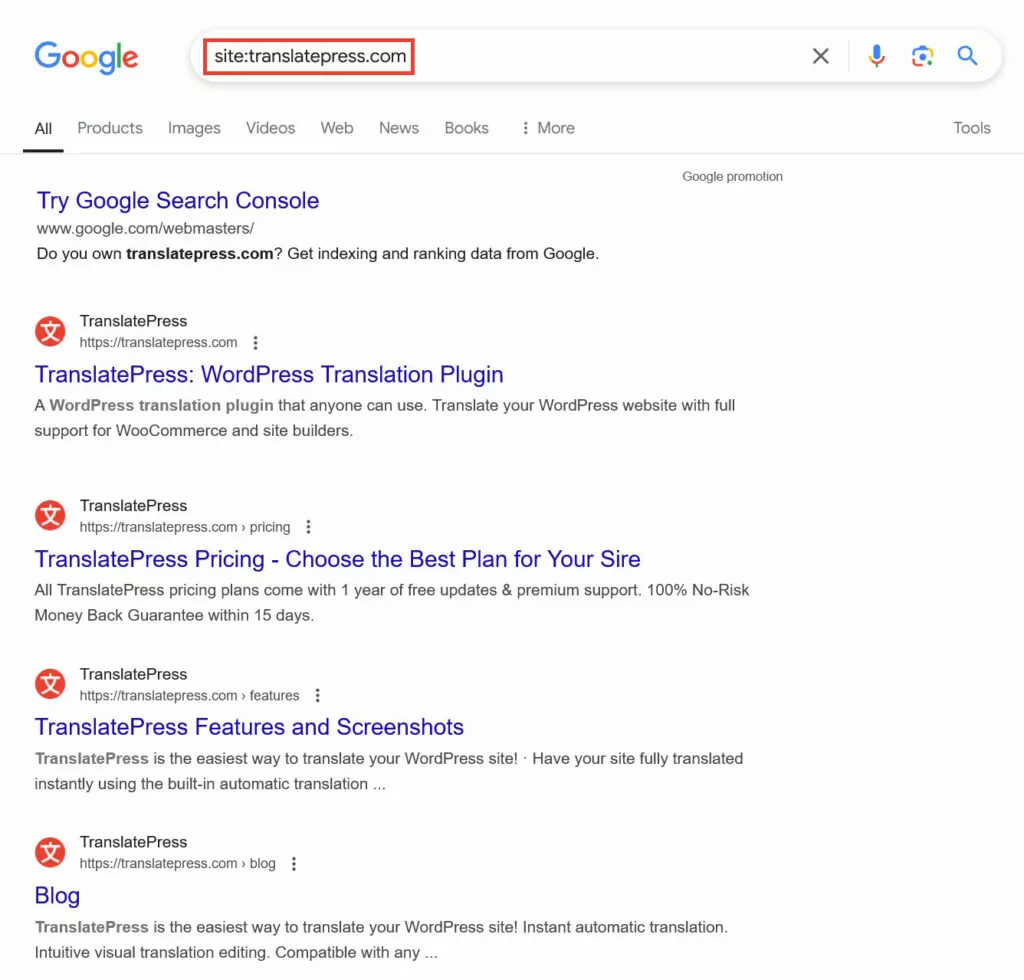
If nothing shows up even though your site has been online for a while, there is likely an issue preventing it from being indexed.
Check Google Search Console
Search Console is a free Google tool that can tell you a lot about your website and how the search engine perceives it, including whether there is an indexing issue. Once your site is connected, you can check the Indexing report to see how many of your pages Google has saved in its index and identify any issues preventing it from doing so.
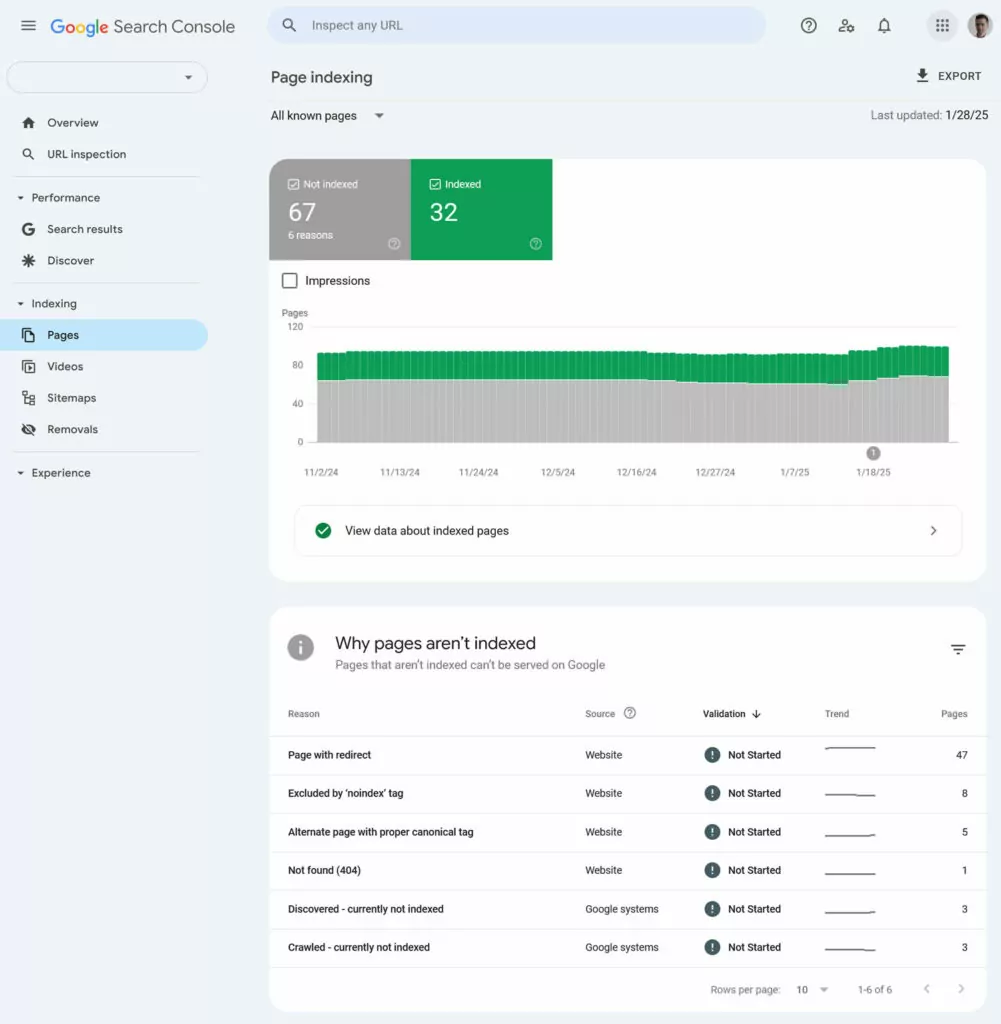
Create and Submit a Sitemap
A sitemap is one of the best ways to tell search engines about your site’s content. It’s essentially a list of all the pages on your website.
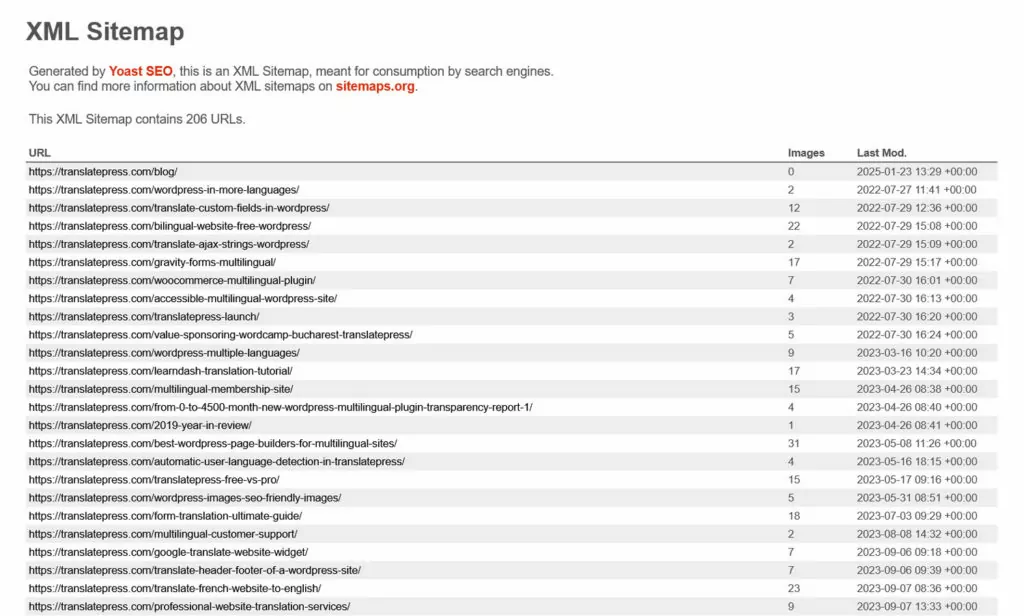
You can use a service like XML-Sitemaps.com to create it for you. Once ready, you need to upload your sitemap to your website’s directory on the server via FTP. If you use WordPress, you can automate this process with a sitemap plugin. WordPress SEO plugins also usually offer this functionality.
Most sitemaps are accessible via yourwebsite.com/sitemap.xml or yourwebsite.com/sitemap_index.xml. With this address in hand, you can submit it to Google Search Console via Indexing > Sitemaps. Just paste the sitemap URL and click Submit.

2. Take Care of Your Technical SEO
Technical SEO means optimizing the technical aspects of your website to ensure it performs well in search engines.
Create a Logical Site Structure
A well-structured website makes it easy for both visitors and search engines to navigate and understand your content. Ideally, all content should be reachable within two to three clicks from the homepage.
The best way to ensure a logical structure is to map it out visually.
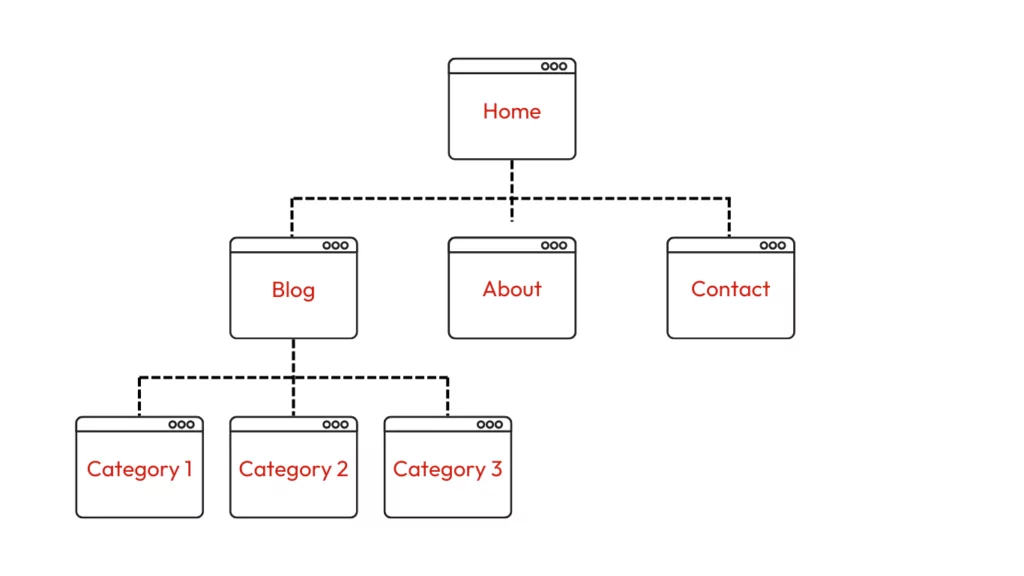
You can connect pages on your site via internal links, such as navigation menus and in-content links (more on that below).
Your URL structure should also reflect your site’s setup. The most common structures are:
- Plain: yourwebsite.com/?p=532
- Day and name: yourwebsite.com/2025/01/23/seo-basics-for-beginners/
- Month and name: yourwebsite.com/01/23/seo-basics-for-beginners/
- Numeric: yourwebsite.com/832/
- Post name: yourwebsite.com/seo-basics-for-beginners/
- Post name with category: yourwebsite.com/seo/seo-basics-for-beginners/
For most websites, the Post name format is the most advisable. Including dates is generally only useful for news sites or similar cases where it makes sense to date your content. If you already have an established site, do not change your URL structure, as it can negatively impact your rankings.
Use HTTPS
Running your site over a secure HTTPS connection has been a ranking factor for years.

If your site is still using http://, it’s important to switch to https:// as soon as possible. To do this, you’ll need an SSL certificate, which many hosting providers offer for free.
If your website is already well-established, migrating to HTTPS needs to be carefully planned to redirect traffic properly and avoid losing rankings.
If you feel like this is outside of your wheelhouse, consider getting help from an experienced developer.
Avoid Duplicate Content
Duplicate content can occur when the same or very similar content appears on multiple pages. For example, in WordPress this often happens because the platform automatically generates different archives for authors, dates, categories, and tags.
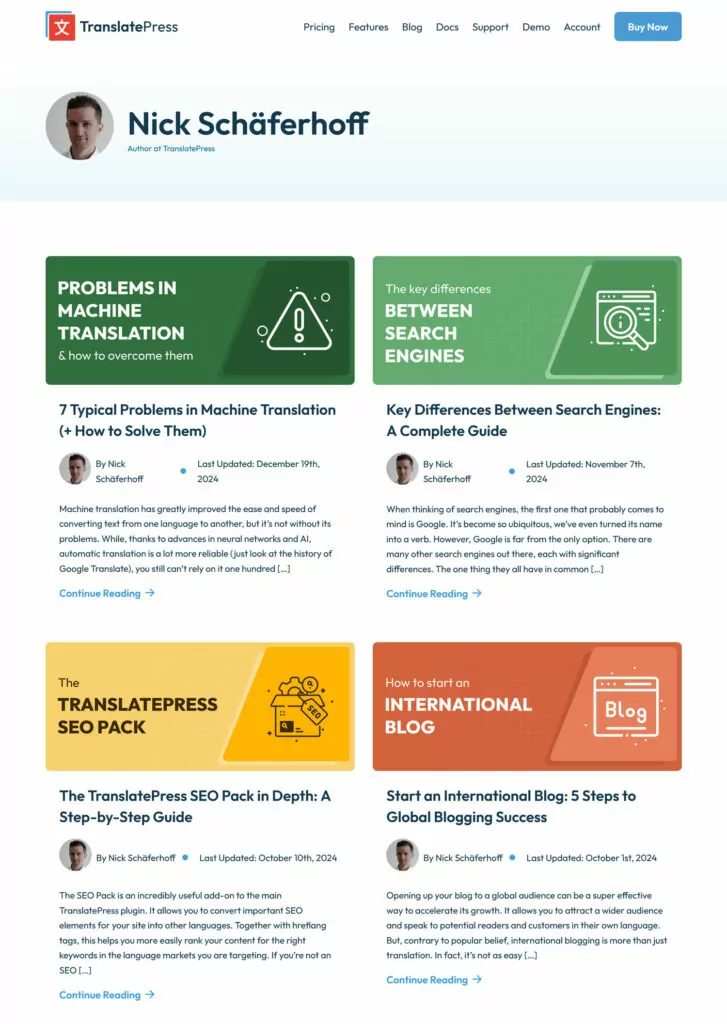
If your site has only one author, the author archive and main blog page will contain identical content. While this isn’t necessarily a problem for search engines, it can create a poor user experience and waste crawl resources so that your desired pages don’t make it into the index.
To address this:
- When republishing content elsewhere, use canonical tags to specify the original version of a page.
- Add descriptions to category pages to differentiate them from other archive pages that may feature the same blog posts.
- Disable irrelevant archives (such as tag pages) to prevent multiple archive pages from displaying the same content.
3. Do Keyword Research
Keyword research means finding out what people type into Google when looking for content like yours.
By identifying these search terms, you can better understand your audience’s interests and create content that addresses their needs, increasing the chances of ranking in search results.
Keyword research is best done using tools like Google Keyword Planner, Ubersuggest, Semrush, or Ahrefs. These tools can tell you a lot of information like search volume, keyword competition, related phrases, and more.
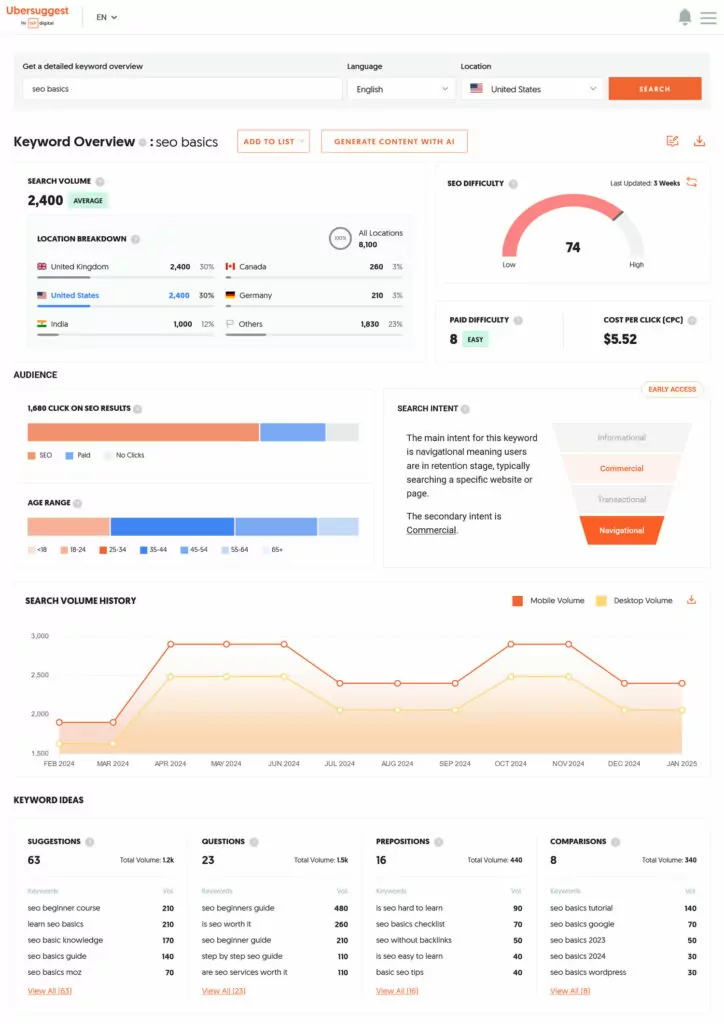
Besides that, keyword research works like this:
- Brainstorm ideas: Think about what you would type into a search engine to find your website, services, or content. You can also look at the keywords your competitors target for additional ideas.
- Expand your list: Use keyword research tools to generate additional keyword suggestions. KeywordTool.io is great for quickly finding related terms.
- Refine your selection: Once you have a good list, the goal is to find keywords that have enough volume to be worth your while but also low enough competition so that you have a chance to rank high for them. Remember: most clicks go to the top results, so it’s better to rank at the top for a specific keyword with low volume than rank low for a high-volume keyword.
If your site includes pages in multiple languages, things do get a little more complicated, as you will need to do this research for every language you want to rank your website in. Luckily, we have a guide for this too, so if you need help with this, check our post on international keyword research.
4. Create High-Quality Content
Content is a big deal in SEO. It’s one of the main ways to bring visitors to your website (looks like it worked on you!). To maximize its effectiveness, you need to understand the basics of SEO-friendly content creation.
Understand Search Intent
Search intent refers to the reason behind a user’s search query. There are four main types of intent:
- Transactional: Someone wants to buy something (e.g., “buy translatepress”)
- Commercial: Someone is considering a purchase and trying to find the best option (e.g., “best wordpress translation plugin”)
- Informational: Someone wants to learn about a certain topic (e.g., “seo basics for beginners”)
- Navigational: Someone wants to find a particular website (e.g., “spotify”)
Google places significant emphasis on matching search intent with relevant content. If your content doesn’t fit the user intention, it’s unlikely to rank well.
The easiest way to do so is to simply google your keyword and then analyzing results. For example, when you search for “grilled cheese sandwich”, Google delivers mostly recipe pages.
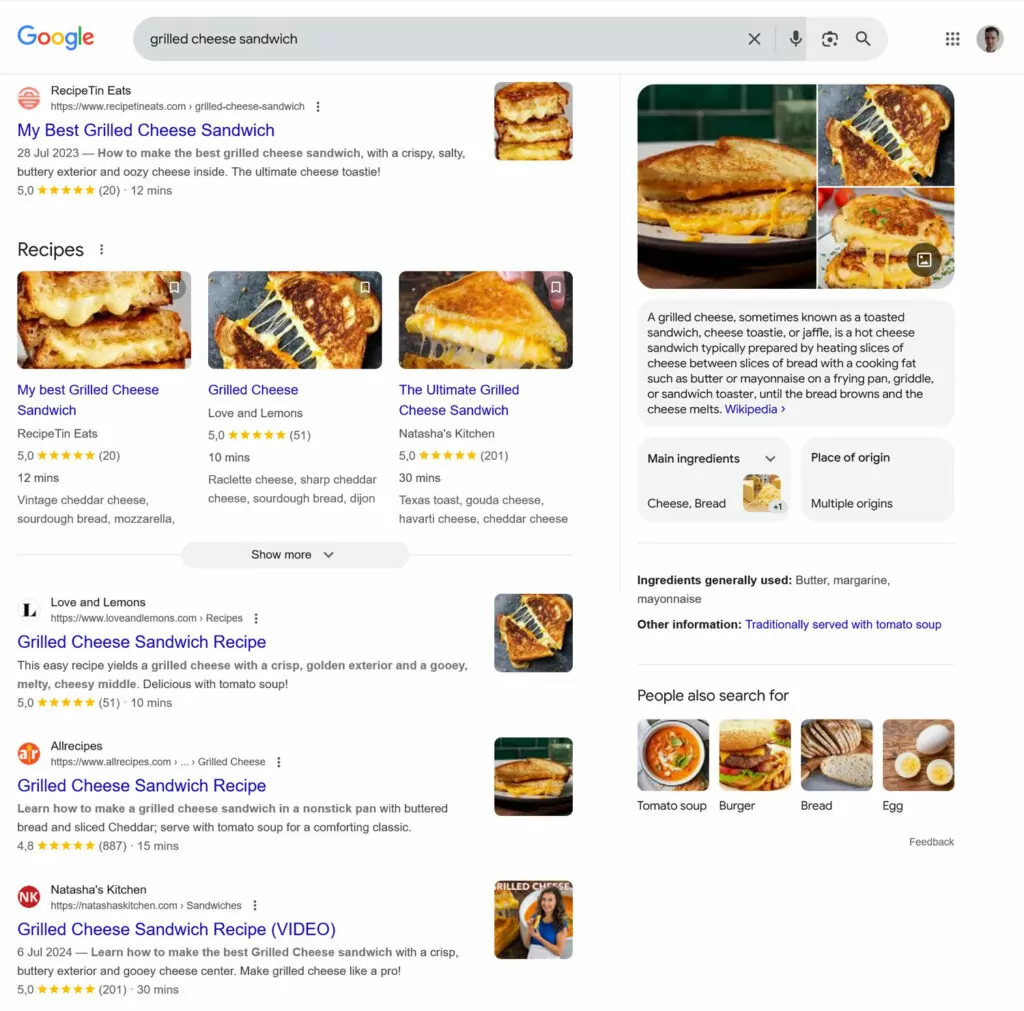
So, if your goal is to rank for this keyword, that’s likely what you should also create. For even more detail, click on the results and look at their structure, layout, word count, etc.
Make Your Content Valuable, Unique, and Readable
Once you’ve determined search intent, the next step is to produce content on your chosen keyword that provides real value.
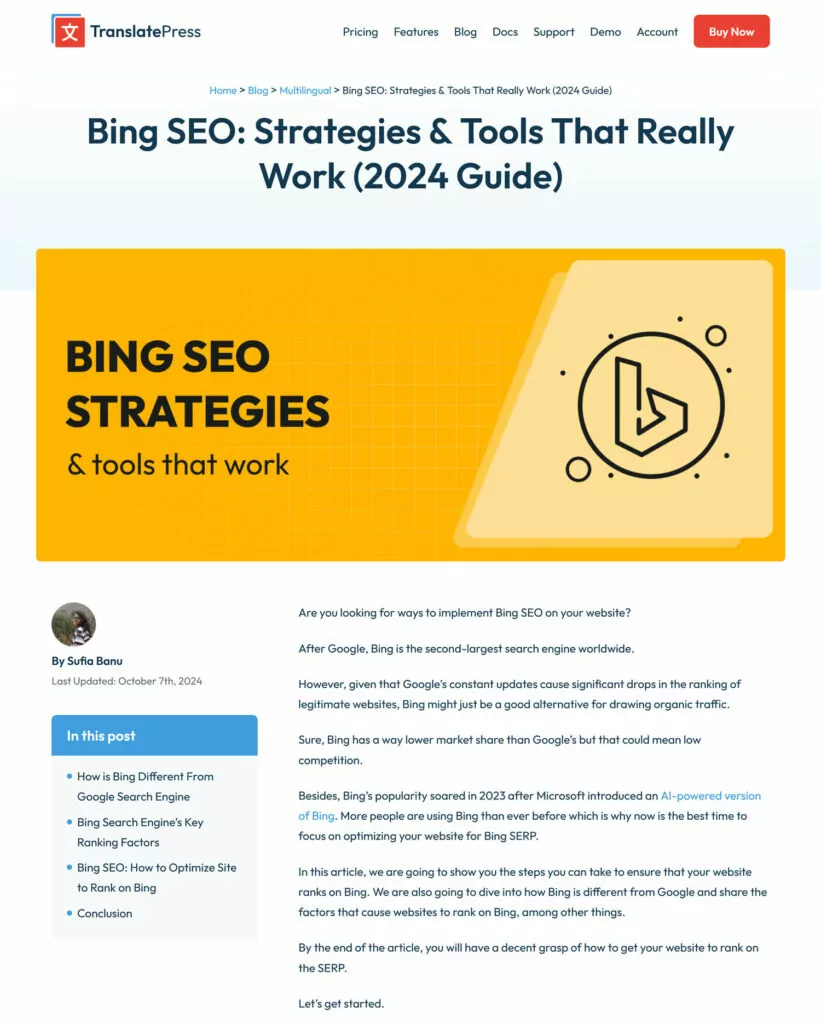
That means:
- Write for people first, not search engines: Ensure your content genuinely helps the reader and fulfills their intent.
- Make it unique and authoritative: Don’t simply copy existing content—add new insights, perspectives, or original research. Link to trusted sources when necessary.
- Ensure readability: Use short sentences, clear paragraphs, and proper formatting (headings, bullet points, and numbered lists).
Use Images
Images enhance user experience by breaking up text, illustrating concepts, and making content more engaging. They can also help with SEO and help you appear in Google Image Search.
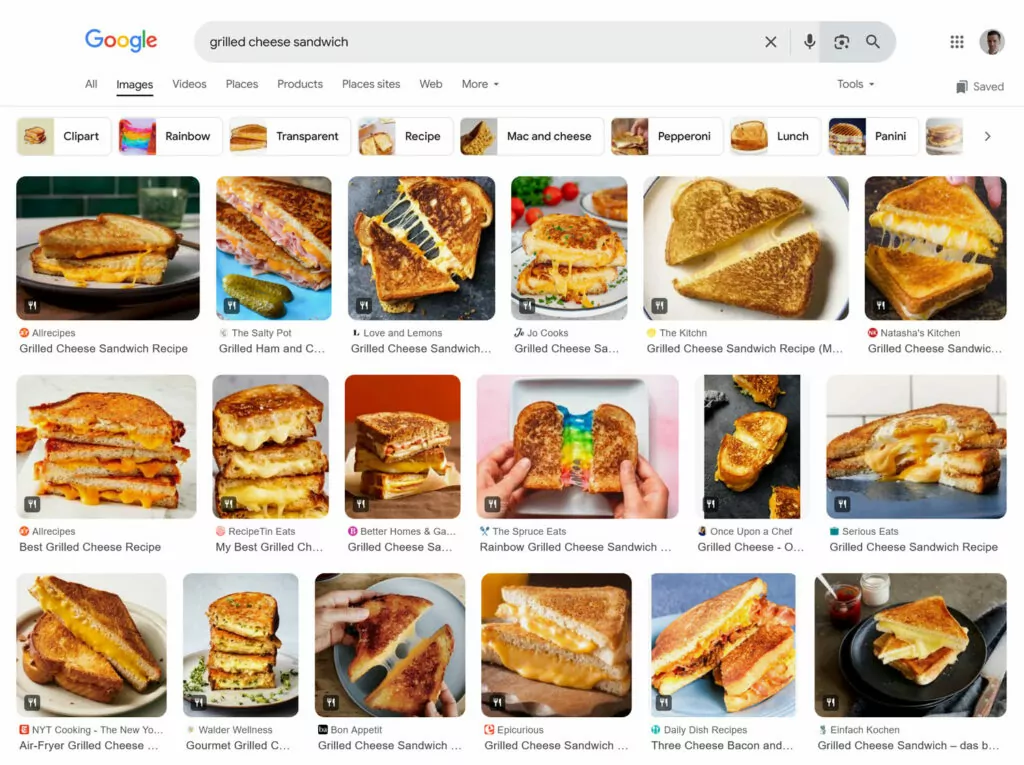
To use images the right way:
- Use high-quality visuals that are easy to read and see.
- Avoid generic stock photos—use unique visuals where possible.
- Make sure images are relevant and support your content.
And once again, if you’re running a multilingual website and write content in different languages, make sure the quality aligns in all language versions, not just the main one.
5. Offer a Great User Experience
User experience (UX) refers to how enjoyable and easy it is for visitors to use your site. Good UX helps users find what they are looking for easily. It also impacts SEO because Google tracks user engagement metrics like time on page and bounce rate to assess content quality.
If visitors quickly leave your site after clicking on your link in search results, it signals a poor user experience, which may result in lower rankings. Of course the opposite is also true.
Improve Site Speed
If you have ever clicked away from a website because it took too long to appear or was overall sluggish, you know the effect of site speed on user experience. Website speed is also a ranking factor.
You can find out how fast or slow your site is by inputting it into a tool like PageSpeed Insights. It will identify speed issues and provide suggestions for improvement.
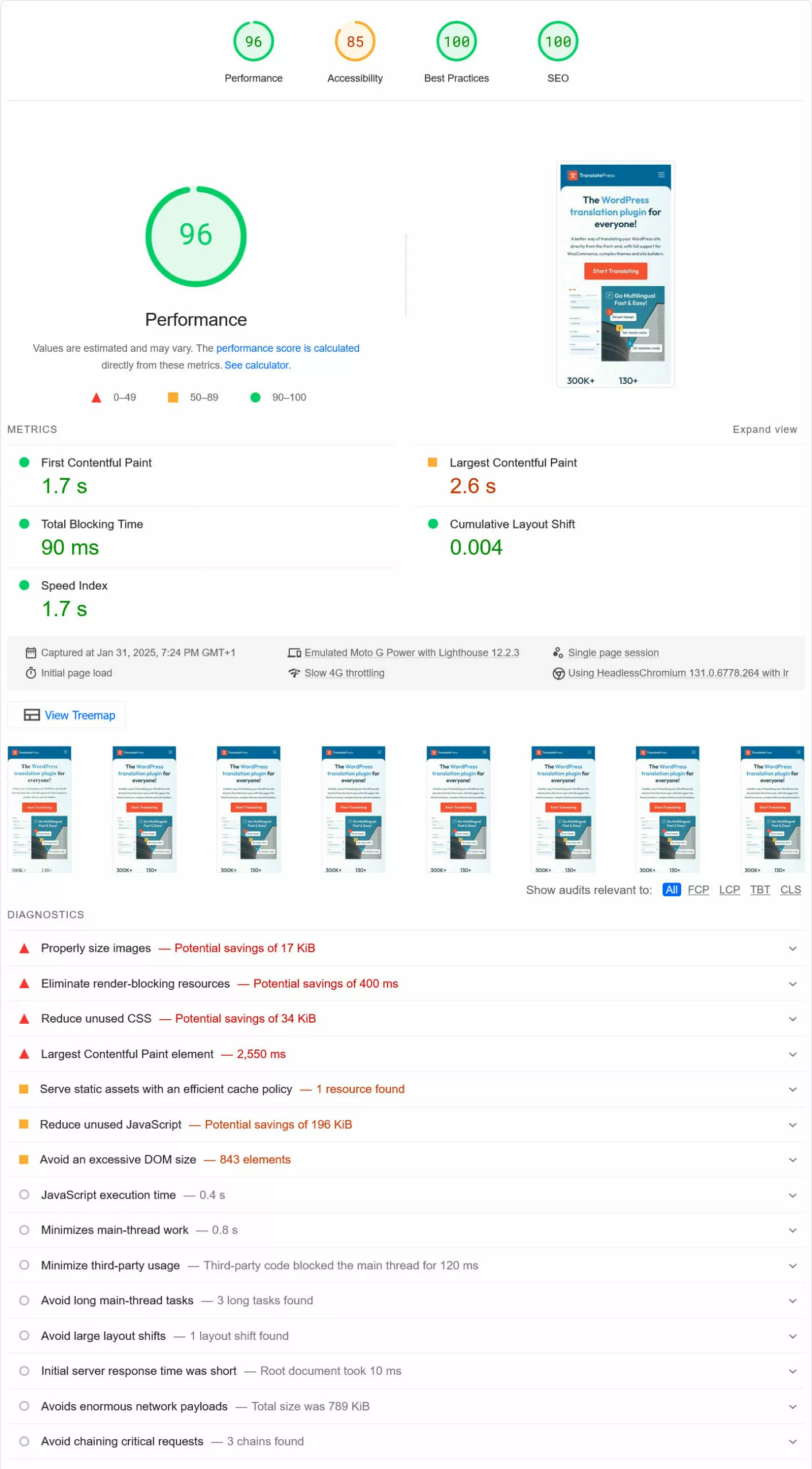
Pay special attention to the report on Core Web Vitals. They are a set of performance metrics that directly measure aspects of user experience. A Search Console report tells you if there are problems with Core Web Vitals on your site and provides help with fixing them.
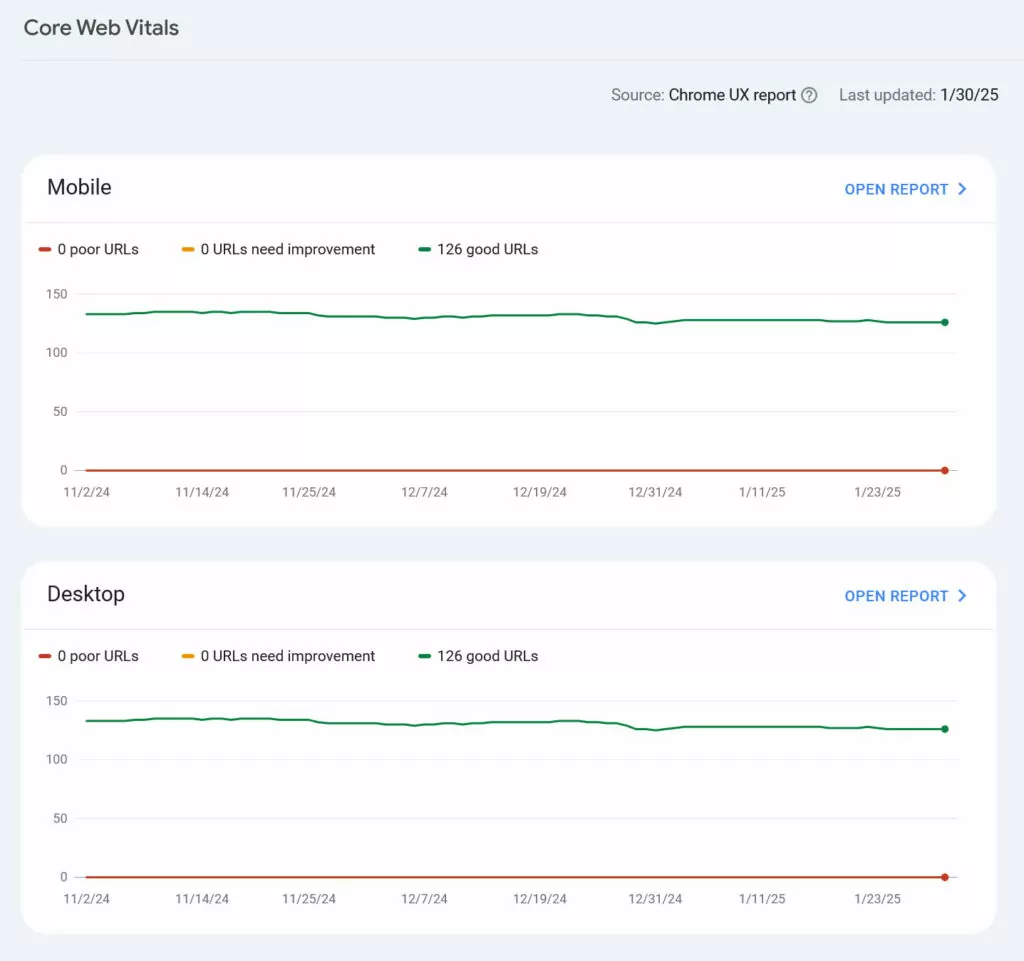
Mobile-Friendliness
Google uses a mobile-first index, meaning it prioritizes the mobile version of your site when determining rankings.
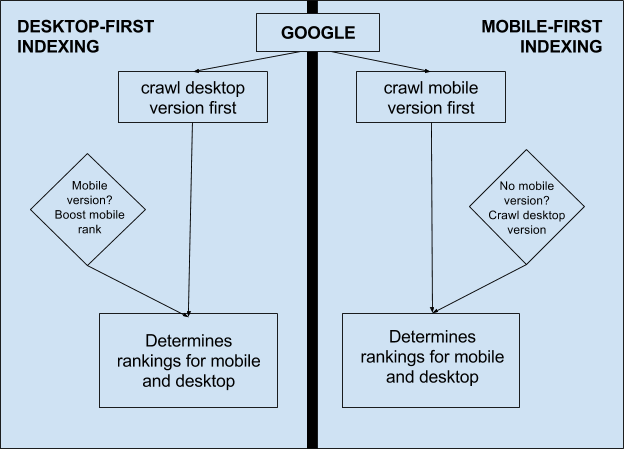
This is because mobile users now outnumber desktop users. It also means having a mobile-friendly website is an absolute necessity.
To improve mobile usability:
- Use a responsive design that adapts to different screen sizes.
- Optimize page speed on mobile devices (Google PageSpeed Insights has a separate mobile section).
- Ensure navigation elements, buttons, and forms are easy to use with a touchscreen.
- Check that content stays readable on smaller screens
Avoid Distractions
A clean, distraction-free website keeps users focused on your content. Avoid excessive ads, intrusive pop-ups, and autoplay videos, as they can drive visitors away.

6. Learn On-Page SEO
On-page SEO means optimizing individual pages to improve their chances of ranking for specific keywords. Let’s go over the key elements.
Title Tag
The title tag appears as the main clickable headline in search engine results.

It’s a crucial ranking factor because it appears prominently and tells search engines (and users) what the page is about. A good title tag should:
- Be unique, clear, concise, and provide an accurate description of the page content.
- Include the main keyword naturally.
- Stay within 50-60 characters to avoid truncation.
- Be compelling enough to encourage clicks.
If you are using WordPress, the title tag automatically corresponds to the title you input at the top of the editor.

You can customize and preview it with an SEO plugin like Yoast SEO.
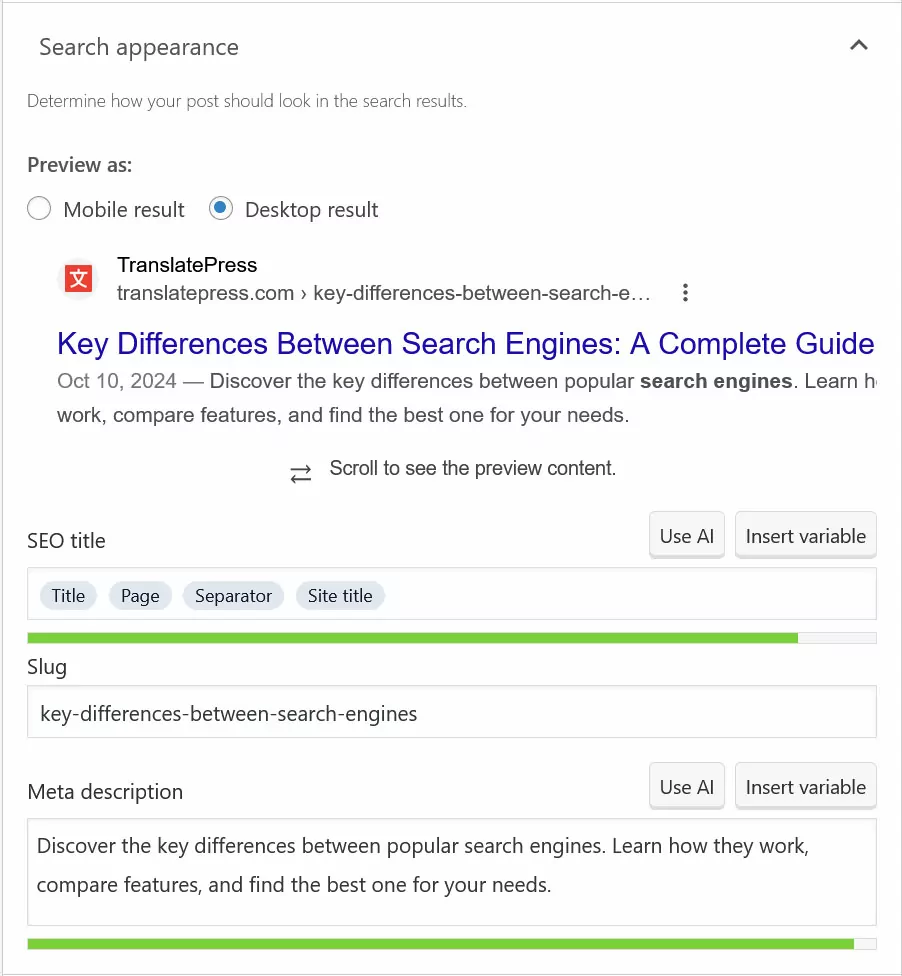
Plugins like Yoast also offer on-page SEO analysis, which contain invaluable advice for beginners who are just learning the basics of SEO.

Meta Description
The meta description is a short summary of your page’s content that can appear below the title in search results.

While not a direct ranking factor, it’s a great opportunity to entice searchers to click on your link, which can indirectly improve ranking.
To get the most out of it:
- Keep it under 160 characters.
- Accurately summarize the content of your page
- Incorporate the main keyword naturally.
- Include a call to action.
In WordPress you can use an SEO plugin to create and preview your meta descriptions.
Heading Tags
These are HTML tags that structure your content and make it easier to read for both visitors and search engines. There are different levels, from H1 to H6.
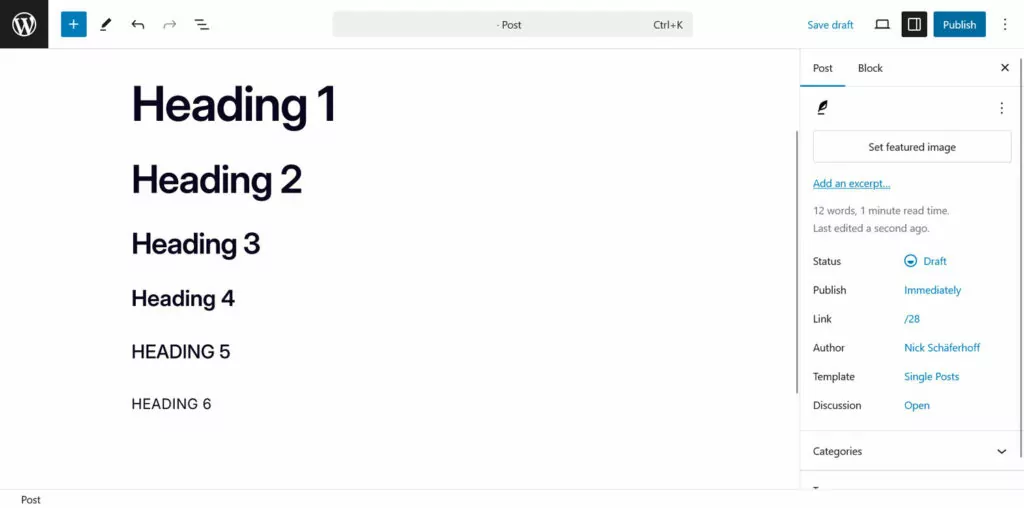
Here’s what you need to know:
- Each page should have only one H1 tag (usually the page title).
- Use H2s for major sections and H3-H6 for subsections.
- Include keywords naturally in headings where relevant.
Images
To make your images SEO-friendly:
- Use descriptive file names (e.g., seo-tips.png instead of image1.png).
- Include alt text, which is a short description that helps search engines and visually impaired users understand the image content, e.g. “web analytics dashboard on a laptop screen.”
In WordPress, you can save alt text in the media library and customize them per page in the editor sidebar.
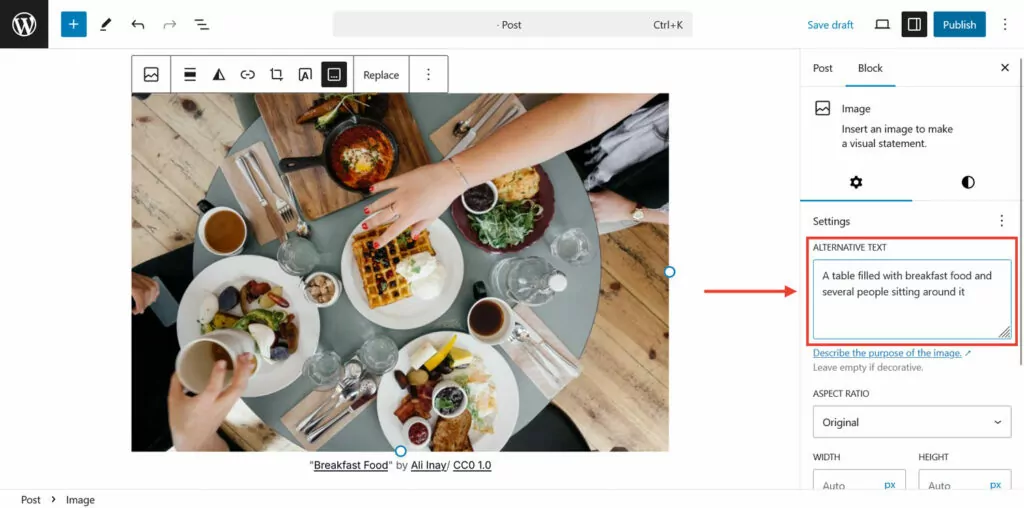
Internal Links
Linking between pages on your website accomplishes several outcomes:
- Points out related and important pages to visitors.
- Helps search engines understand your site structure.
- Passes incoming link authority to other pages.
Therefore, whenever you create new page or post, make sure to include links to other relevant parts of your site. In addition, regularly add new links to existing pages as well.
In addition, use descriptive anchor text, meaning the text that appears as the link on the page such as the following link to our article on SEO for Bing.
It should make it clear what kind of page it’s leading to. However, avoid always using the same exact keyword as your link text, which isn’t encouraged by Google.
Page URL
You page URLs should also be concise and descriptive. Compare these two examples:
- yourwebsite.com/?p=532
- yourwebsite.com/seo-basics-for-beginners/
Which one gives you a better impression of the page you’ll land on?
For best results, make your URLs:
- Short and concise
- Separated by hyphens
- Written in lowercase
- Optimized with the main keyword
7. Engage in Link Building
Links are one of the most powerful ranking signals. High-quality backlinks (meaning links pointing to your site) from reputable websites tell Google that your content is valuable, which helps improve your rankings. However, not all links are equal—quality matters more than quantity.
The practice of trying to get more links for your site is called “link building.” Let’s go over some techniques.
Create Linkable Assets
One of the most basic link building strategies is to create content that naturally attracts links. In short, to make it so good that others want to link to it.

The first step to do so is to follow the advice for creating quality content above. Aside from that, it helps to invest in popular content forms such as:
- Original research and studies
- Infographics and charts
- Expert roundups and interviews
- Case studies and whitepapers
Reach Out to Your Network
Your immediate network is a good source of backlinks. Start by contacting business partners, colleagues, and industry connections who may be willing to link to your content.
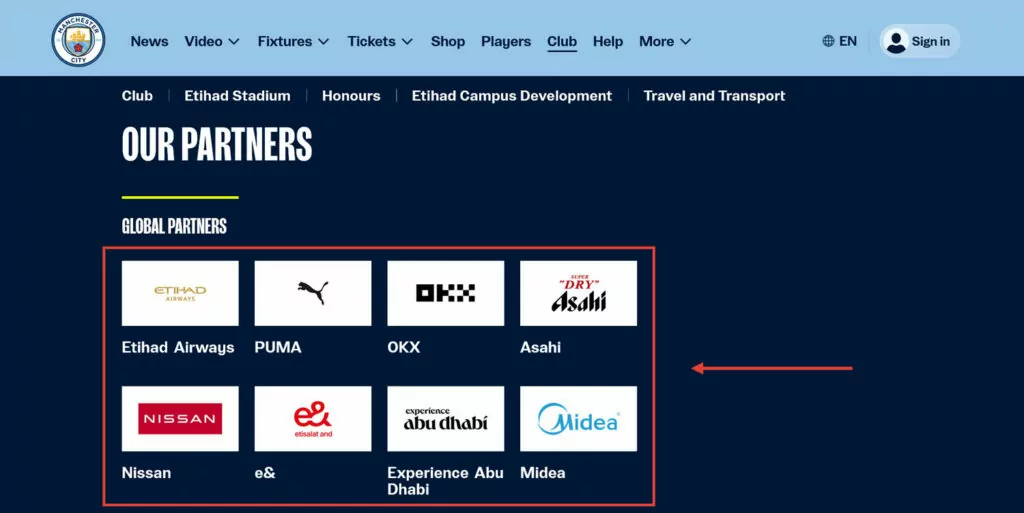
This is an easy way to get your first backlinks.
Submit to Relevant Directories
For local businesses, online directories can be a valuable source of backlinks. Think Yelp or Yellow Pages.
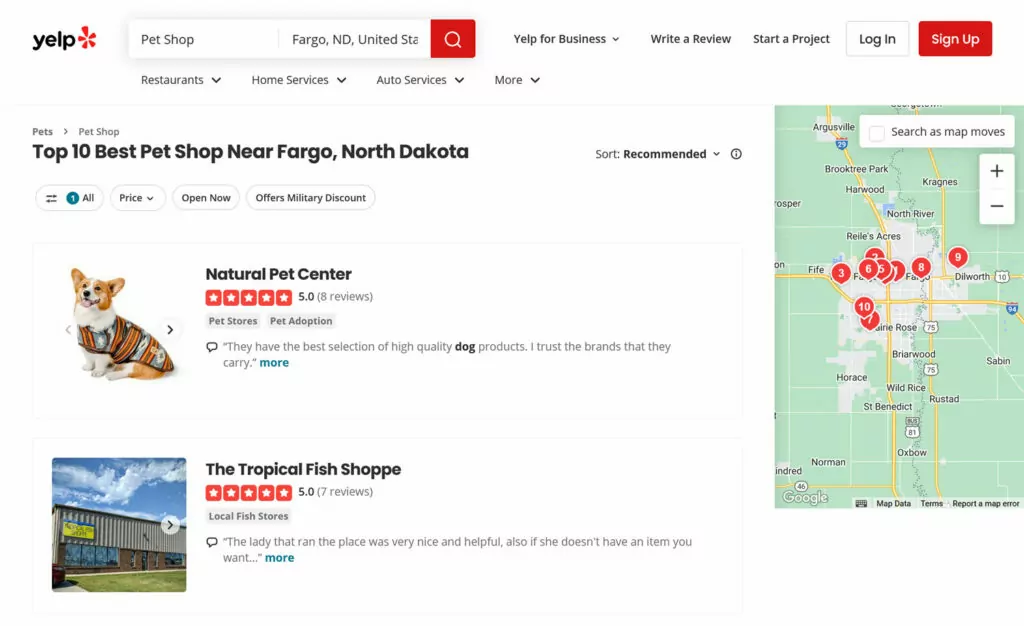
However, when you go this route, focus on high-quality, industry-specific directories instead of low-value spam varieties.
Do Outreach and Guest Blogging
Aside from that, link building is often about reaching out to other websites for links. A popular way for that is guest blogging. It works like this:
- Find relevant websites that accept guest posts.
- Pitch relevant, high-quality content.
- Naturally include a backlink to your site within the article.
Alternatively, you can reach out to site owners and suggest replacing broken links on their website with links to your relevant content.
Generally, don’t worry about link building too much at the beginning. It’s hard work and quite advanced. Your first priority as a beginner is to get the absolute SEO basics right.
8. Master Local SEO Basics
Local SEO is essential if you run a brick-and-mortar business or serve customers in a specific geographic area. It helps your business appear in location-based searches, such as Google Maps results and the local three-pack in search results.

Set Up Your Google Business Profile
The most important step to take for this is to create your Google Business Profile. This is where the search engine gets the information it displays for local search results.
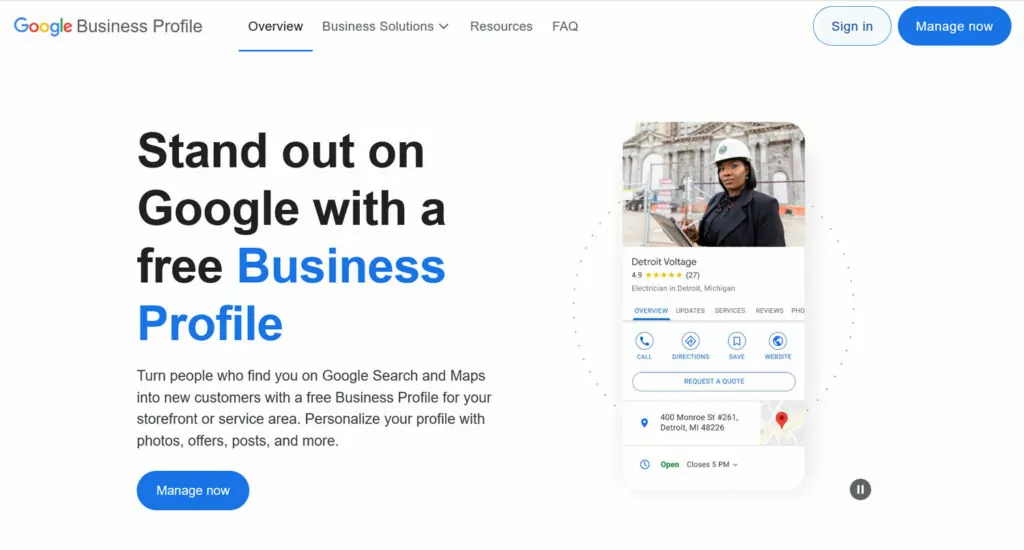
To improve your chances of outranking the competition, take advantage of everything it has to offer:
- Fill in business details: Provide a clear description of your business, update contact details, set business hours, and ensure your NAP (name, address, phone number) is consistent with other directories.
- List your services and products: This allows your business to appear for relevant searches like “best vegan ramen in [city]” or “SEO agency near me.”
- Provide photos and videos: Add images of your store, office, team, or products to enhance your profile and give customers a taste of what to expect.
- Encourage and respond to reviews: Positive reviews boost trust and visibility. Respond to all feedback, including negative reviews, to show engagement.
Use Location-Based Keywords
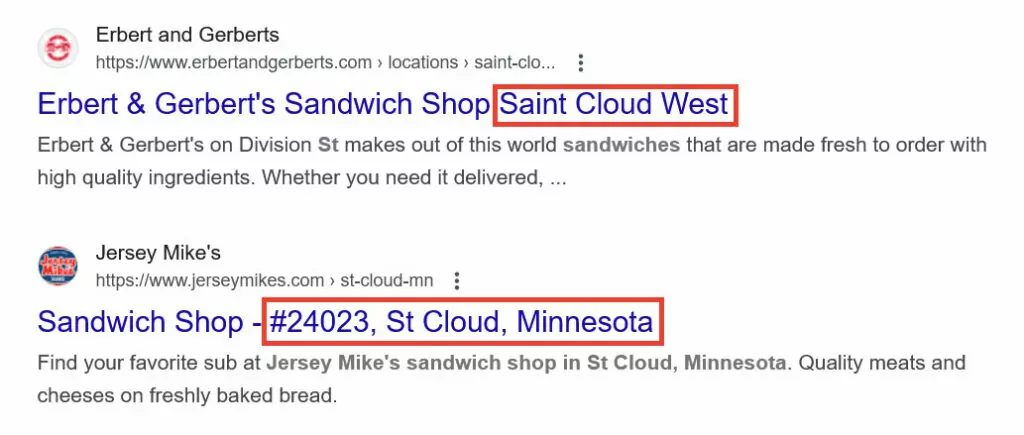
To improve local rankings, integrate location-specific keywords throughout your website. Examples include:
- Your city, neighborhood, or region in meta titles, descriptions, and content
- Location-based landing pages if you serve multiple areas
- References to local landmarks or events when relevant
Additionally, list your business in trusted local directories to strengthen your local presence.
9. Track Your SEO Performance
You can only tell if your SEO is working if you have a way to measure it. The most important free tools for that are the aforementioned Google Search Console as well as Google Analytics.
In Search Console the Performance report shows how your website is doing in search results.
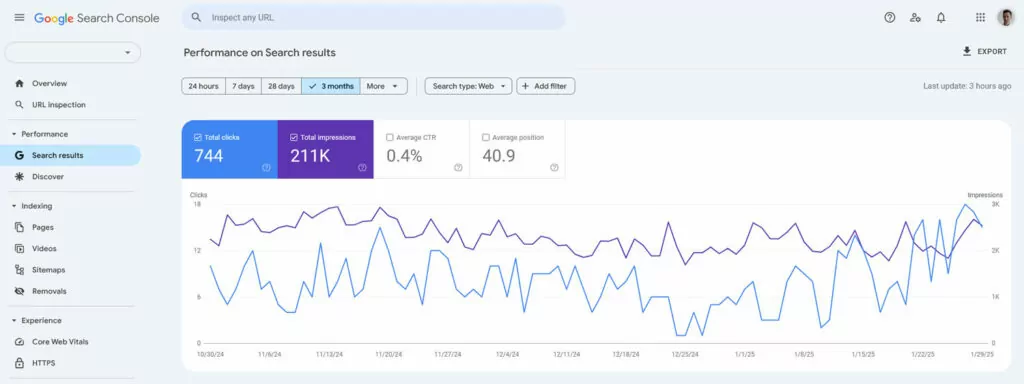
You can see:
- Total clicks and impressions
- Average position in search results
- Click-through rate (CTR)
- Keywords your site and pages rank for
Google Analytics additionally provides insights into visitor behavior on your site.
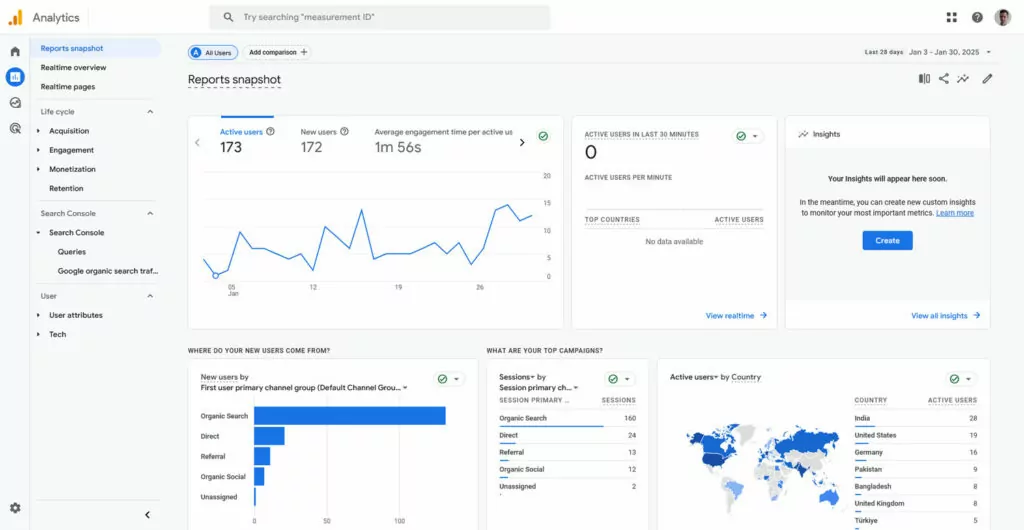
It helps track:
- Where your visitors come from (organic search, social media, referrals, etc.)
- Which pages they visit most
- Engagement metrics like bounce rate and session duration
- Conversion rates (e.g., sign-ups, purchases, or other goals)
By analyzing these metrics, you can fine-tune your SEO strategy. Just remember that it’s a long-term process. It takes consistent effort to see better results.
Don’t Forget About Your Multilingual SEO Basics Too
If your website targets more than one language market, your international SEO strategy is another base you need to cover to ensure search visibility. TranslatePress is an excellent tool to help you with that because, if done right, it can help you grow your website to global audiences pretty fast.
1. Add Extra Language With Ease
After you install the plugin, to add one or more languages, head over to Settings → General. Choose your default language, then use the drop-down menu under All Languages to select your target language(s). Click Add to finish.
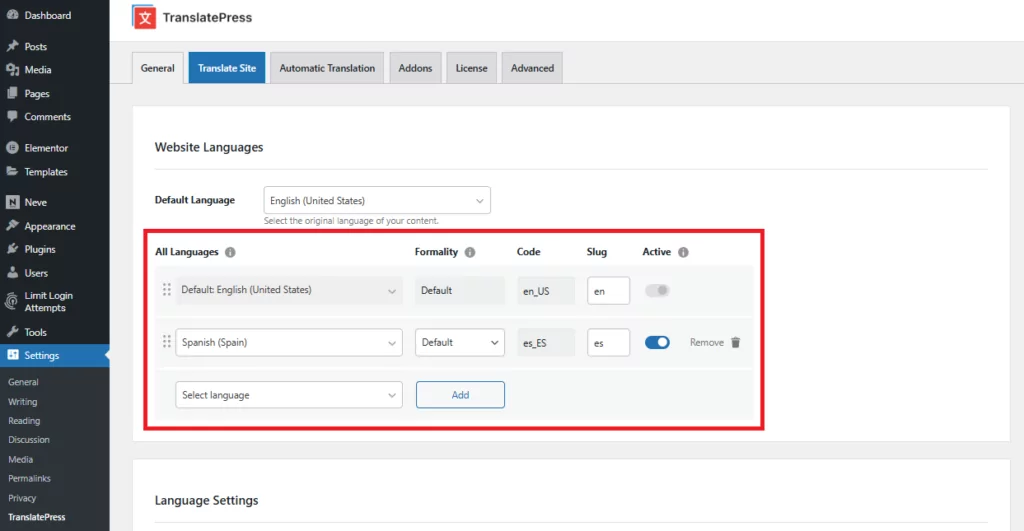
Save at the bottom and you are done.
2. Automatically Translate Your Content With AI
Doing international SEO requires translating and localizing your content. TranslatePress offers several to do so. The most hands-off method is using TranslatePress AI.
To take advantage of it, access the Automatic Translation tab and switch the drop-down menu under Enable Automatic Translation to Yes. Then save at the bottom.
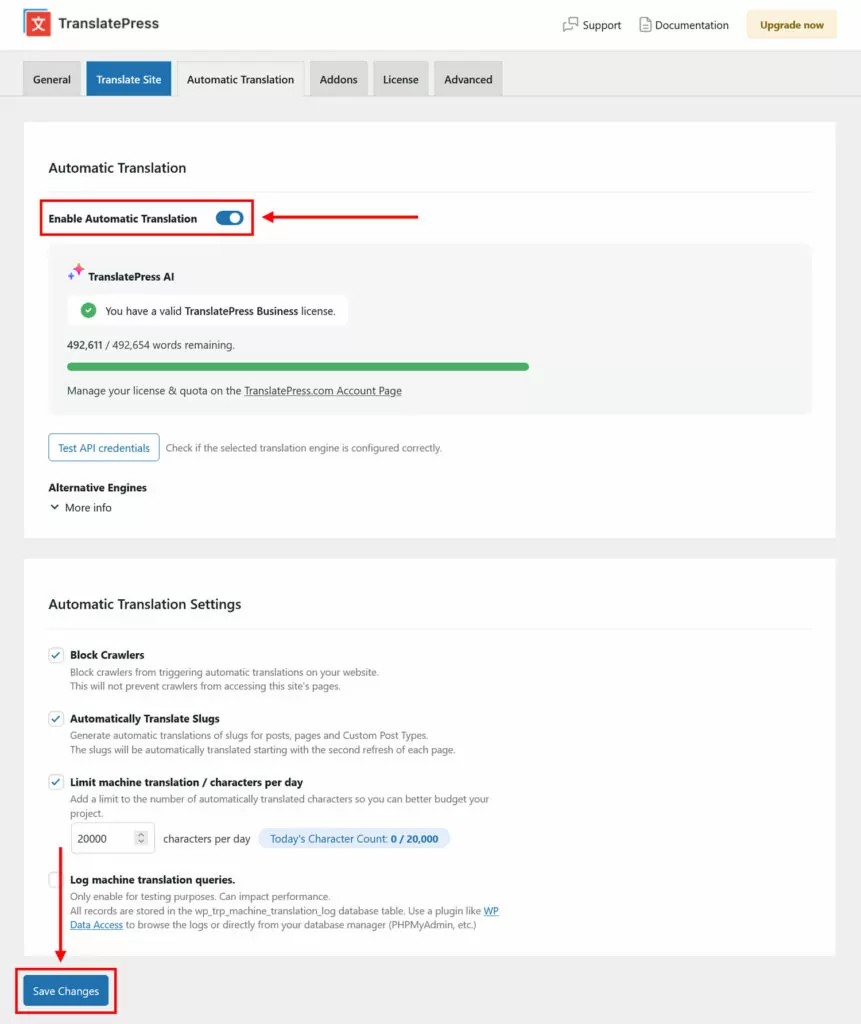
TranslatePress AI, the integrated automatic translation engine, will immediately start converting your website to your target language(s). You can see it right away when you use the language switcher on the front end of your site.
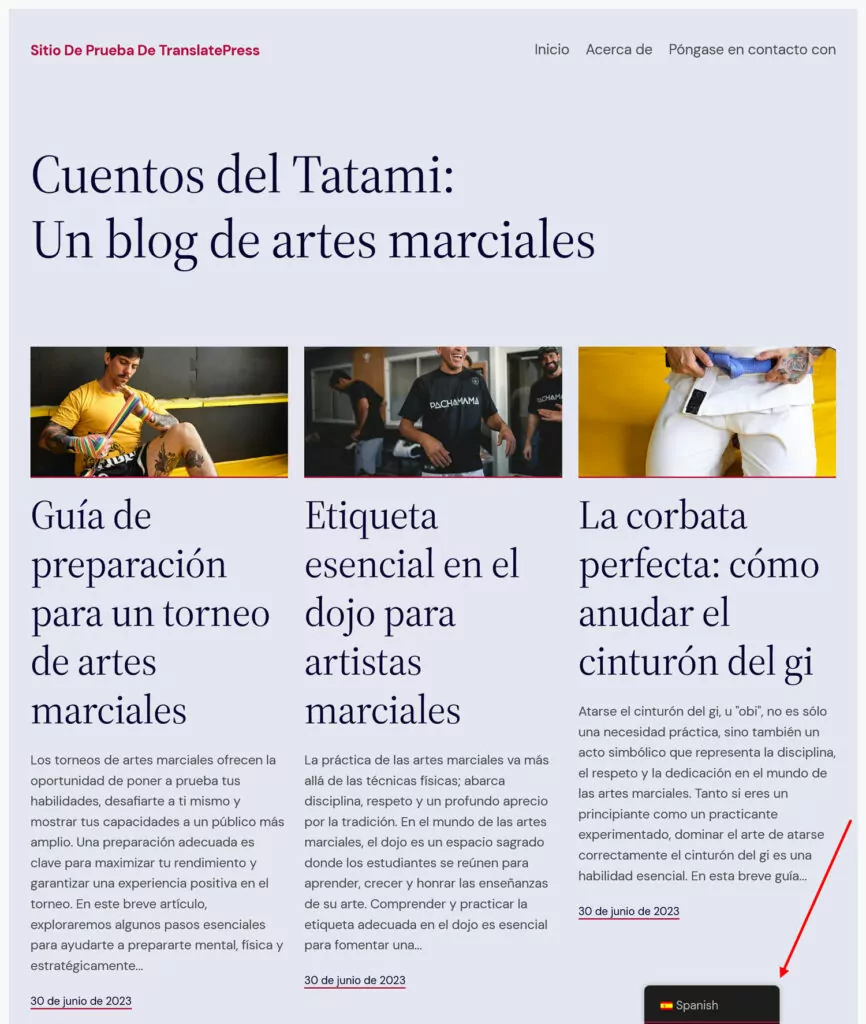
TranslatePress AI does not just convert your posts and pages to your target language(s), but also menus, widgets, themes, plugins, and even SEO metadata. It’s a great way for beginners to cover their absolute SEO basics.
Be aware, however, that the free version offers a limited number of AI words to translate, but if you need more, you can upgrade to a premium TranslatePress license at any time.
3. Take Advantage of Other Translation Engines
AI is not the only machine translation option. Still in Automatic Translations, under Alternative Engines, you can also choose Google Translate (if you have a TranslatePress license, DeepL is also available).

Obtain an API key using this guide for Google Translate or this one for DeepL. Once in place, the rest works the same as TranslatePress AI. The translation simply happens by itself in the background.
A quick note: Using Google Translate or DeepL can charge additional fees depending on your usage. TranslatePress AI, on the other hand, has no extra costs outside the plugin.
4. Make Manual Corrections
You also have the option to do translations by hand. This can be either to correct automatic translations or simply add translated content manually.
For that, you need to go to the TranslatePress translation interface. Click Translate Site in the settings or the WordPress taskbar to access it.
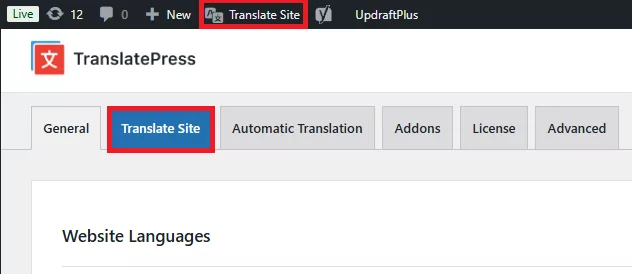
The interface contains a preview of your site on the right and shows translation tools on the left.
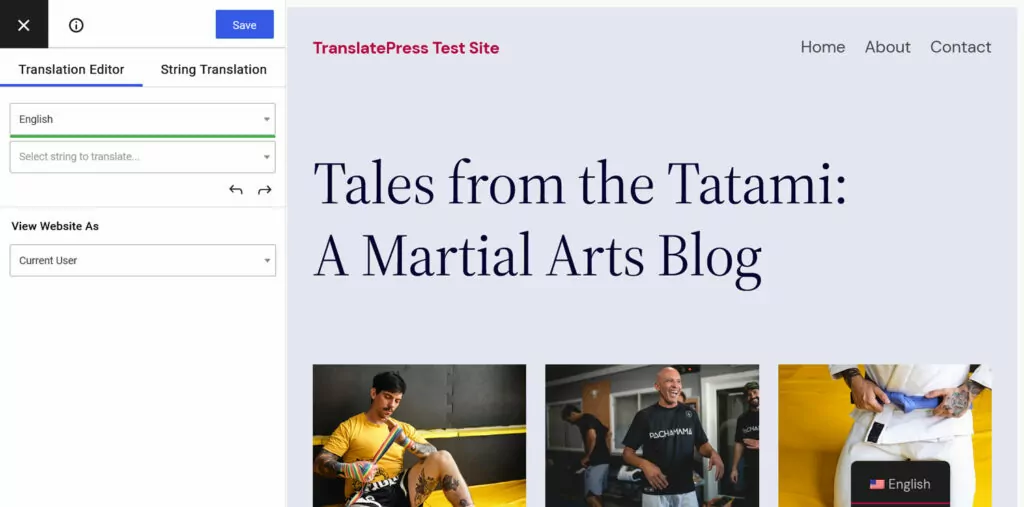
The drop-down menu at the top allows you to see content in your target language.
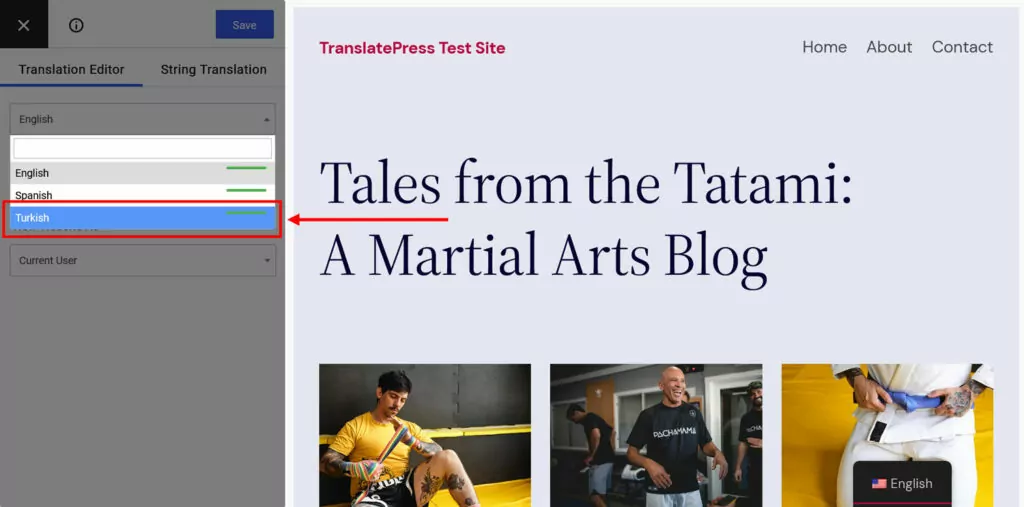
Use the preview window to navigate to the text you want to correct or translate. Use either the second drop-down menu, the forward and backward arrows, or click it in the preview screen.
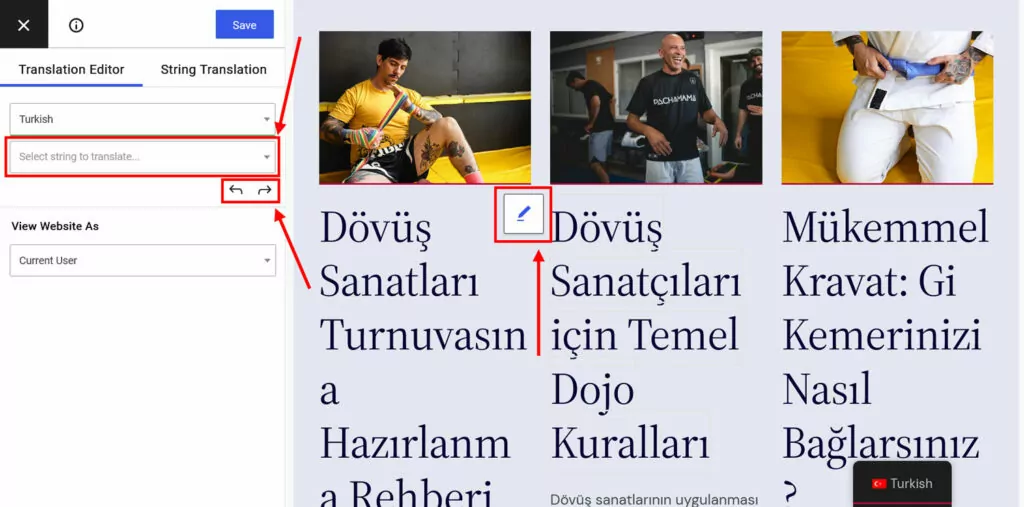
When you do, a new field appears on the left containing the automatic translation or space for your own, handcrafted one.
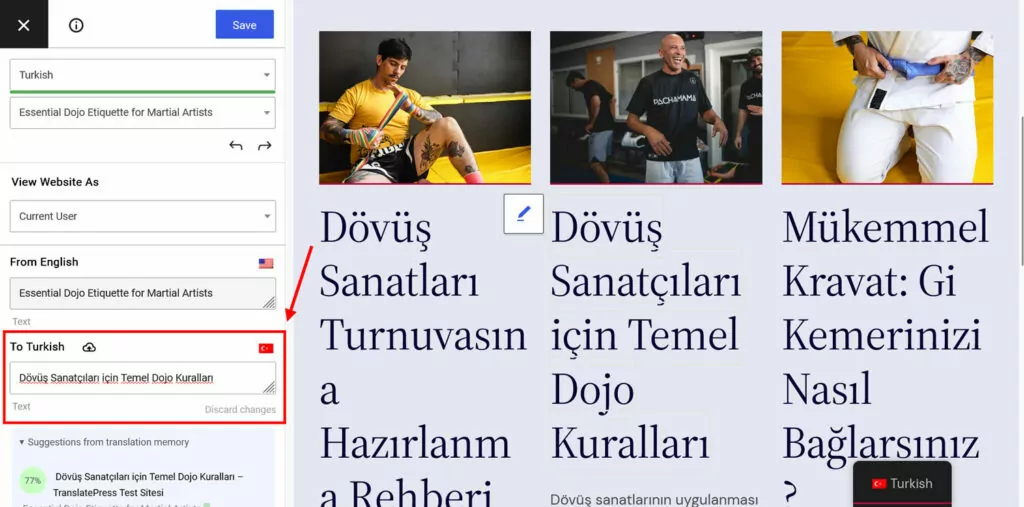
Input what you need, then click Save at the top or press Cmd/Ctrl+S on your keyboard. The corrected or translated string will automatically appear on your site.
The process is the same for translating images. Click to select one, then input a link to the localized version or pick it from your WordPress media library.

5. Take Advantage of the SEO Options
Implementing SEO basics with TranslatePress is easy—even for beginners. For one, the plugin automatically implements hreflang tags for all your chosen languages. This clearly marks your translated content for the correct language and locale.
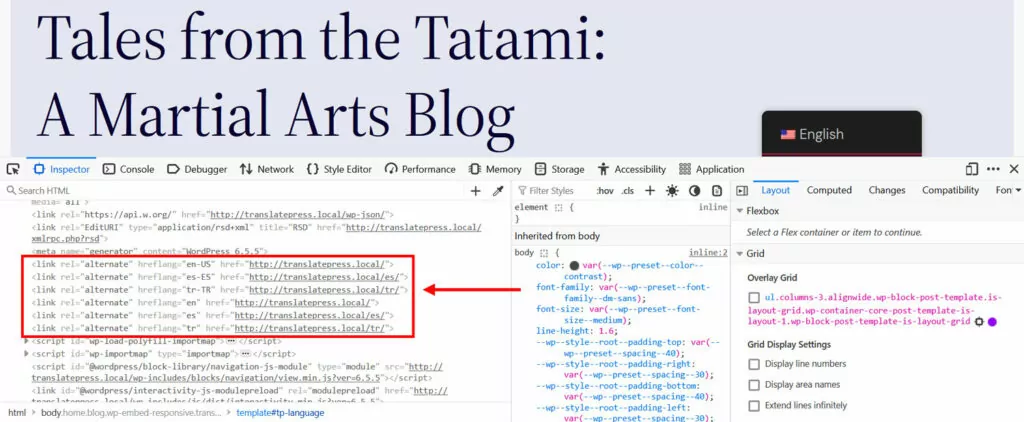
In addition, TranslatePress Pro comes with the multilingual SEO pack. It lets you translate all of the SEO markers we talked about above, including:
- Title tags
- Meta descriptions
- Alt text
- Page URLs

Plus, the SEO Pack creates multilingual sitemaps you can submit to search engines and works with most of the popular WordPress SEO plugins. Together with the ability to easily translate content, this covers pretty much all your on-page SEO bases.
The free version of TranslatePress is enough to add one more language to your site. For additional languages and more features to improve your multilingual SEO, check TranslatePress Pro. It comes in three pricing tiers so you can find the right option for yourself.
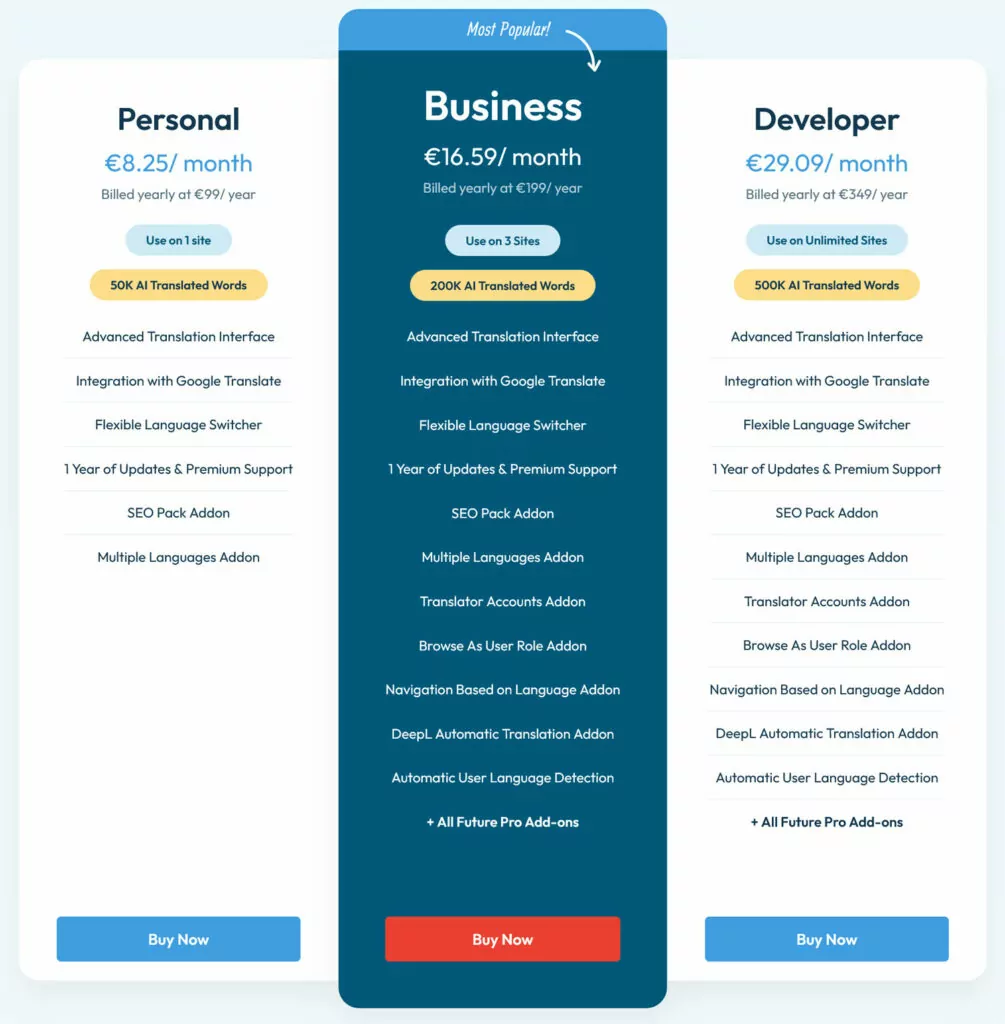
Beginners, Get Your SEO Basics in Order
Don’t worry if SEO seems overwhelming at first. In the end, it all comes down to understanding how search engines categorize and rank websites and making sure you adhere to their requirements. Cover the basics, optimize your content, and it quickly becomes second nature. The rest is just repetition and patience.
In the meanwhile, if you need assistance with ranking your website in several languages, give TranslatePress a try!
